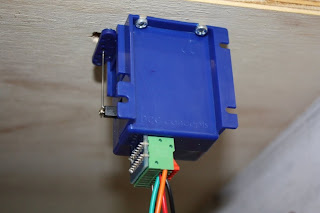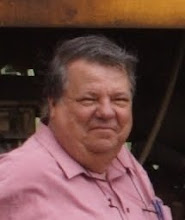Raymond and I finished the track laying and wiring for the station and yard which we had started some time ago. The reason being the Tuesday Nighters (alias Mackie’s Marauders) were coming to visit on Tuesday, 14 June. Their previous visit was supposed to view this station and yard completed to a stage that we could run some trains but that was not to be. They even had given us a month’s warning but we failed miserably.
 A scene across the yard looking towards the station (depot) area, the carriage sidings and an industrial siding (with the K-37 standing on it)
A scene across the yard looking towards the station (depot) area, the carriage sidings and an industrial siding (with the K-37 standing on it)You will have read about our problems with point motor decoders and I had mentioned we were going to use NCE SwitchIt and Switch8 decoders which we have found very satisfactory. The Switch8 is very easy to program as there is a numbered dial on the decoder where you select the point you are wishing to program using a small screwdriver to select which point you are programming. The Switch8 will control up to eight points. The SwitchIt is slightly more difficult. It will control two points but you have to use a jumper wire across terminals to select which points you are programming.


Those of you who have been reading my blog will notice that recently I tried referring to points as turnouts which is probably more correct but I have been using the term points for more than 50 years as that is what my father (a signalman in the railways) always called them. I tried using the word turnout in one of my earlier posts but I kept falling back into my old habit of calling them points and it was becoming tedious to keep going back and changing the terminology, so I won’t “kick the habit” and will continue calling them points.
Raymond installed the two sets of points at the left-hand end of the yard (nearest the sliding door). He then installed the Cobalt point motors and an NCE SwitchIt decoder and all the wiring. He used many choice words in doing this (he talks to himself a lot) as he tried to fit the Cobalt motors and wire each up. A major problem we found was that the baseboard framing along the front of the steel shelving brackets was made using an L-Girder using a 4 X 1 with a 2 X 1. I am a great believer in Lynn Westcott’s L-Girder construction method as it makes very strong yet light baseboard frame. I had placed the 4 X 1 in the horizontal position as I thought I would need to do this to access the screw holes in the metal brackets to secure the L-Girder to the metal bracket/wall framing. This proved to not be the case when inspecting the layout.
Raymond’s problem was that some of the Cobalt motors and also the wiring fittings were above that piece of 4 X 1 which made access impossible to either mount the motor or install the wiring or both. This caused Raymond lots of frustration and thus the choice words. The answer, as suggested by the Tuesday nighters previously was to use a Spade Bit to drill a hole through the 4 X 1 to give access to a screwdriver to mount the motor and also install the wiring. However, the Spade Bit was very messy.


When we do the right-hand side of the shed in August which will also use this double-slotted tubing and brackets I will make the L-Girders of 2 X 1 and 2 X 1 which as experience has shown will still give us some “meat” to fix the L-Girder to the metal bracket. This will mean that in future the L-Girder will not get in the way of the installation of the point motors.
We have purchased some scenic materials from Ray Nunn at Austral Modelcraft and our second work trolley is now kitted out. The top tray has all our track laying and most of the wiring materials while the bottom tray has an assortment of scenic textures, ballast and sundry material. I want to make a bracket to support the spools of wire across the trolley but will leave that for the time being.
We are still discussing how we want to do the scenery. I must confess, despite being involved in the hobby for more than 50 years this will be the first time I have actually tried to apply scenery material on my own. Most previous occasions I have just been a “gopher” assistant or an onlooker when the model railway clubs I have been in have been applying scenery to their club or display layout. To me, scenery is still a “magic art” and I have nothing but admiration for those who make it look so easy to come up with a masterpiece that looks so life-like.
Needless to say, the Tuesday Nighters came over on Tuesday. 14 June and I think they were suitably impressed with work so far. Brendan ran a train and others watched. The usual bull session discussions took place with everyone comparing notes. Every time a train went past on the Uniform Gauge Railway which runs past our back fence a number of the Nighters would race outside the shed to see what they could see. I must forgive them as they are New South Wales modellers after all. I don’t think there is a narrow gauge bone in their bodies. I tried to turn Brendan to the dark side (of On30) but, although he was interested in our layout and asked many questions as this was the first time he had visited us, and enjoyed running a train backwards and forwards I think he is too committed to his New South Wales “stuff”.



Although we want to start on the scenery side of this first station, Raymond and I have been discussing our material requirements to continue the layout across to the right-hand side of the shed.

Another great night at the depot, I love the track arrangement, plenty of shunting opportunities. On30 does present plenty of opportunities for modellers, after I've finished with the other 'stuff' and as the eyesight fails, I'm sure it will be an option, just gotta build another train room!
ReplyDeleteThanks for another good night, Geoff.